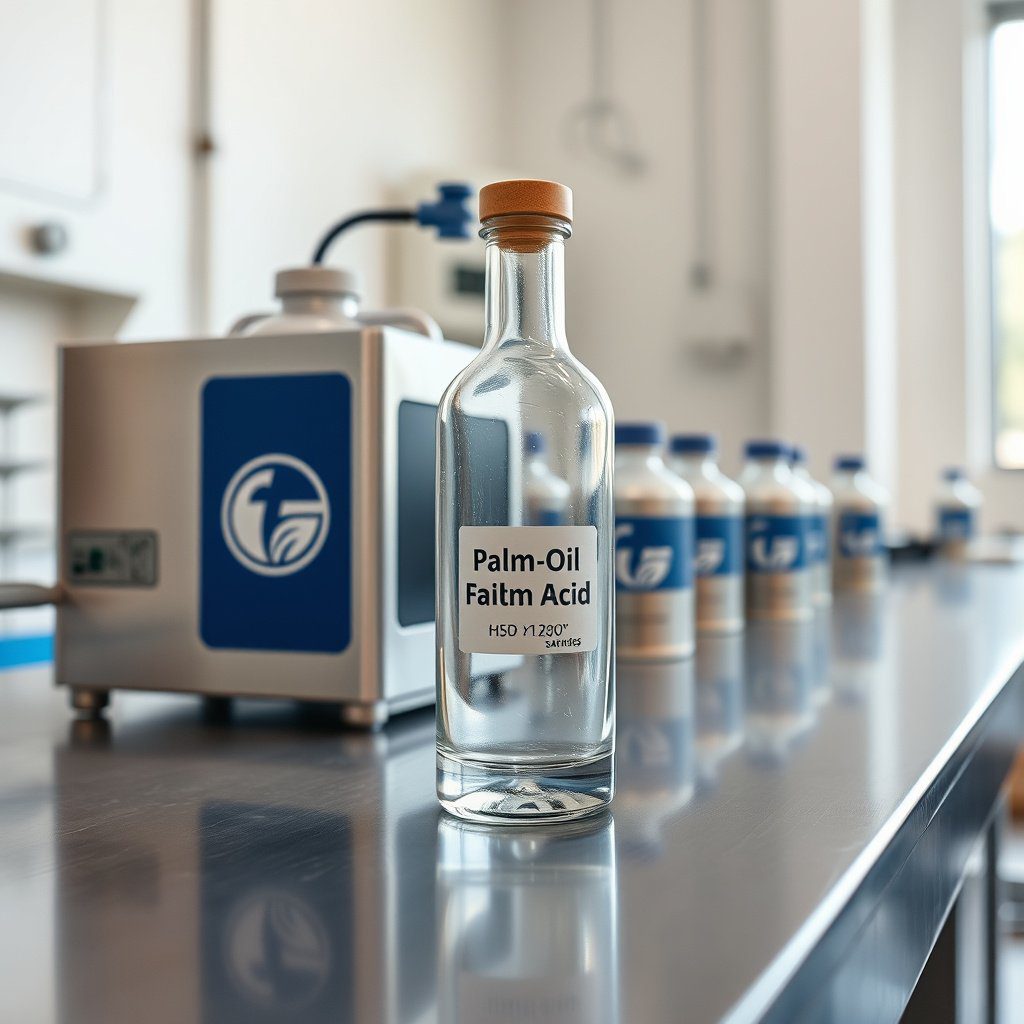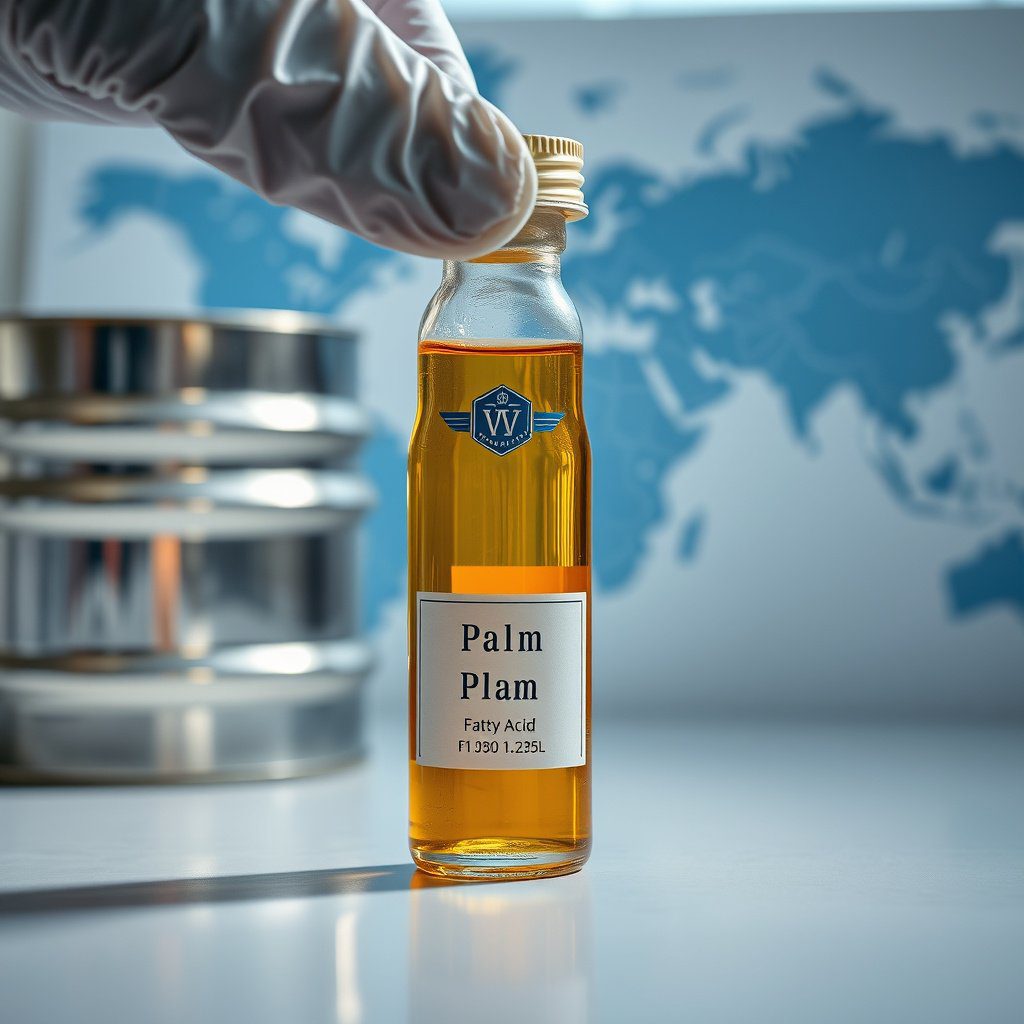Shortening palm oil fatty acid delivery lead times is a strategic lever for manufacturers relying on PFAD and PFAD-derived products for oleochemicals, nutraceuticals, cosmetics, and industrial applications.
In a market where global demand fluctuates with crop cycles, regulatory changes, and shipping capacity, palm fatty acid logistics must be treated as a core capability, not a back-office function.
This guide blends proven practices with practical, field-tested insights drawn from two decades of experience in chemical and oleochemical distribution.
Our approach integrates regional network design, real-time visibility, collaborative planning, and data-driven forecasting to keep your supply chain resilient and your production lines uninterrupted.
At Diplomata Comercial, we translate complexity into predictable delivery windows, leveraging a global footprint, stringent quality controls, and a reputation built on trust with partners in HPPC, pharma, industrial chemistry, and nutrition sectors.
The result is streamlined lead times, improved service levels, and a partner who speaks your language—whether you’re optimizing a single plant in the Americas or coordinating multi-country logistics across continents.
Understanding Palm Fatty Acid Logistics: Lead Times, Risks, and Opportunities
In palm fatty acid logistics, lead time is a function of sourcing, transit, handling, and regulatory clearance.
A practical way to shorten lead times is to map these components from end to end and identify bottlenecks before they become disruptions. Lead times can be influenced by harvest cycles, refinery scheduling, port congestion, and customs clearance timelines.
By understanding where value is added and where friction occurs, you can implement targeted changes that produce measurable improvements.
For mid-market and enterprise buyers, the goal is to move from reactive problem-solving to proactive orchestration—ensuring supply continuity even when external conditions tighten the schedule.
Within this landscape, the palm fatty acid logistics ecosystem comprises producers, traders, freight forwarders, and distributors.
A robust network reduces the distance between demand centers and reliable PFAD sources, while ensuring traceability and compliance across borders.
In practice, the most effective arrangements combine regional sourcing and storage with digital platforms that provide real-time visibility into inventory, shipments, and ETA.
Our experience shows that companies that align procurement, logistics, and commercial teams around shared KPIs outperform those that treat these functions as siloed activities.
The payoff is not just shorter lead times; it is higher on-time delivery, lower expediting costs, and a more resilient supply chain overall.
Key Lead Time Factors
The first factor is supplier proximity.
Regional sourcing can dramatically cut transit times and reduce exposure to port delays.
The second is inventory strategy—having safety stock or near-site stock that can bridge gaps when suppliers miss schedules.
The third is process maturity—clear workflows for approvals, QA checks, and document handling that prevent last-minute holds at customs.
Finally, technology maturity—embracing platforms that align demand signals with procurement and logistics execution reduces manual handoffs and error rates.
In short, a cohesive strategy touches people, processes, and platforms in a unified way, creating faster, more predictable PFAD delivery.
Regional Variations in PFAD Supply
PFAD supply dynamics vary by region due to refinery capacity, shipping lanes, and regulatory regimes.
In some markets, high-quality PFAD streams are tightly integrated with regional port infrastructure and feeder logistics, enabling quick turnarounds.
In others, longer lead times may stem from cross-border documentation or limited tanker availability.
The practical takeaway is to tailor your approach to the regional context: prioritize local storage and cross-docking where feasible, while maintaining flexible sourcing options to mitigate localized disruptions.
A regionalized strategy is not isolationist—it is a disciplined approach to reduce exposure to international shipping volatility while preserving global access to premium PFAD grades.
Strategic Network Design: Building Regional Hubs for Palm Fatty Acid Delivery
One of the most impactful moves to shorten PFAD delivery lead times is to redesign the network around regional hubs.
Regional hubs serve as consolidation, storage, and quick-dispatch nodes that shorten the last mile and improve velocity from producer to producer’s site.
The logic is straightforward: shorter distances, fewer handoffs, and greater control over the flow of PFAD.
This approach benefits both supply continuity and cost management, especially when market conditions favor nearshoring or onshore assembly in key production belts.
Diplomata Comercial has spent years shaping such networks for chemical and oleochemical clients, focusing on scalability, traceability, and compliance across multiple jurisdictions.
Locational Advantages of Regional Hubs
Regional hubs provide several advantages.
They enable faster throughput by reducing the number of border crossings and minimize port delays through pre-clearance and pre-positioning of PFAD inventories.
They also facilitate more predictable transit times by standardizing routing and using dedicated lanes or scheduled cross-docking operations.
A well-designed hub network lowers late-stage variability, improves batch traceability, and speeds up emergency replenishment when demand spikes.
In practice, hubs function as the backbone of palm fatty acid logistics, harmonizing procurement cycles with refinery production calendars and customer delivery windows.
Cross-Docking and Inventory Flows
Cross-docking accelerates PFAD movement by transferring shipments directly from inbound to outbound transport with minimal storage.
When implemented thoughtfully, cross-docking reduces handling steps, lowers inventory carrying costs, and shortens lead times for time-sensitive orders.
Successful cross-docking requires robust scheduling, precise inbound/outbound matching, and high-quality data to synchronize product specs and documentation.
Complementing cross-docking with scheduled inventory flows enables a steady rhythm of replenishment that aligns with customer demand and production planning cycles.
Achieving Real-Time Visibility Across Palm Fatty Acid Logistics
Visibility is the backbone of shortened lead times.
When teams can see where PFAD is in transit, predict ETAs with confidence, and react before delays cascade, lead times compress in meaningful, repeatable ways.
Real-time visibility depends on data quality, digital platforms, and the alignment of stakeholders across procurement, logistics, and operations.
Diplomata Comercial leverages digital processes and partner integrations to provide a coherent picture of PFAD movements—from source refinery to customer site—so you can plan with certainty and act with speed when exceptions arise.
Digital Tracking and ETA Accuracy
Advanced tracking capabilities transform raw shipment data into actionable insights.
Real-time temperature, transit time, and location data allow you to adjust routes, reallocate inventory, or switch to alternate carriers before an issue becomes a missed delivery.
ETA accuracy improves decision-making at every step, from production planning to plant-floor scheduling.
A trusted PFAD logistics partner should offer intuitive dashboards, alerting rules, and customizable views that answer questions like: Are we within the target window for next-week production? Do we have a backup plan if port congestion persists? The value is measurable in smoother operations and fewer expediting charges.
Data Quality and Integration
Data quality is not optional; it is the difference between trust and guesswork.
PFAD supply chains rely on data flowing across ERP systems, transportation management platforms, and supplier portals.
Integration should be seamless, with standardized data formats for PO numbers, certificates of analysis, and bill of lading details.
Clean, timely data reduces manual reconciliations, speeds up customs clearance, and supports accurate inventory accounting.
A mature program combines data governance with operational discipline—ensuring the right data is captured, validated, and acted upon at every step of the journey.
Commercial Models and Collaboration to Shorten Lead Times
Commercial arrangements shape the speed and reliability of palm fatty acid delivery.
Well-structured SLAs, collaborative planning, and supplier partnerships that align incentives are powerful levers for reducing lead times.
The best models emphasize transparency, shared risk, and continuous improvement.
Diplomata Comercial has long championed practical commercial frameworks that create predictability and protect margins, while enabling rapid response when market conditions shift.
The focus is not just on price but on the entire logistics experience—from contract design to on-time delivery and quality assurance.
SLAs, KPIs, and Vendor Managed Inventory
Service-level agreements (SLAs) anchored by clear KPIs—such as on-time delivery, documentation accuracy, and response times to exceptions—convert expectations into measurable performance.
Vendor Managed Inventory (VMI) can reduce stockouts and expedite replenishments by transferring some control of inventory management to the supplier, synchronized with your demand signals.
The right mix of SLAs and VMI reduces firefighting, lowers safety stock requirements, and accelerates PFAD delivery by eliminating redundant steps in the approval chain.
A disciplined approach to performance measurement is the antidote to variability in global PFAD supply chains.
Collaborative Planning with Suppliers
Collaborative planning transcends traditional procurement by integrating demand forecasting, production schedules, and logistics capabilities with PFAD suppliers.
Regular alignment meetings, joint risk assessments, and shared improvement roadmaps help ensure that capacity, lead times, and quality targets are harmonized across the network.
This cooperative stance reduces the incidence of last-minute changes, enables proactive capacity management, and ultimately shortens lead times for your PFAD orders.
The key is to move from a transactional relationship to a strategic partnership that adds value for all parties involved.
Transportation Modes and Packaging Ethics for Faster PFAD Delivery
Choosing the right mix of transportation modes and standardizing packaging can shave days off PFAD delivery cycles, especially when shipments cross regions with varying infrastructure.
Tank-containers, road hauls, and rail can be combined to optimize transit time and maintain product integrity.
Packaging standards and documentation controls are equally critical, preventing delays caused by nonconforming packaging or inconsistent labeling.
A disciplined approach to transportation and packaging helps ensure PFAD arrives on-spec, on-time, and with the appropriate documentation for seamless customs clearance.
Tank Containers, Rail, and Road Synergies
PFAD moves can be efficiently managed through a combination of tank containers for intercontinental or cross-regional moves and road transport for last-mile delivery.
Rail can be an attractive option for shorter, land-based routes where it fits the network design.
The objective is to minimize handling, reduce transfer times, and lower risk of contamination or quality loss during transit.
A well-coordinated multimodal strategy balances cost, speed, and reliability, delivering tangible lead time reductions without compromising safety or compliance.
Packaging Standardization and Quality Control
Standardized packaging reduces the risk of delays at loading, unloading, and storage facilities.
Consistent labeling, accurate Certificates of Analysis, and clear lot coding streamline customs and QA checks.
Packaging quality is not a mere compliance box; it directly influences transit speed, product integrity, and customer satisfaction.
By aligning packaging specifications with the expectations of downstream manufacturers, you minimize rework, returns, and outbound delays, keeping PFAD flowing smoothly through the supply chain.
Digital Forecasting, Demand Planning, and Risk Management for PFAD
Forecasting and risk management are the strategic levers that keep lead times predictable in volatile markets.
With palm fatty acids, demand signals can be influenced by regulatory cycles, macroeconomic indicators, and product launches across consumer goods and industrial sectors.
A robust forecasting approach couples qualitative insights with quantitative models, enabling scenario planning and proactive capacity adjustments.
The outcome is a supply plan that supports shorter lead times by reducing over- and under-ordering, and by ensuring the network can meet demand even under stress.
Forecasting Techniques and Scenario Planning
Effective PFAD demand planning blends statistical forecasting with market intelligence.
Techniques such as moving averages, exponential smoothing, and scenario-based planning help teams anticipate shifts in consumer demand, feedstock availability, and refinery scheduling.
Scenario planning is particularly valuable for PFAD, where feedstock supply can be seasonally driven and influenced by geopolitical factors.
By running multiple plausible futures, you can pre-position inventories and select routing strategies that minimize lead time variability across scenarios.
Safety Stock and Buffer Strategies
Safety stock policies must reflect service level targets, supplier reliability, and transit risk.
In palm fatty acid logistics, buffers act as a cushion against port congestion, harvesting delays, or transit interruptions.
The best practices involve tiered buffers by product grade, supplier, and destination, plus dynamic adjustment based on real-time risk signals.
A data-driven buffering approach supports consistent service levels while avoiding excessive carrying costs, helping to keep lead times short without tying up working capital unnecessarily.
Diplomata Comercial: Your Palm Fatty Acid Logistics Partner
With more than 20 years in the chemical and oleochemical space, Diplomata Comercial has built a global reach, deep technical knowledge, and a track record of reliable delivery for diverse industries.
Our team combines scientific understanding with operational excellence to ensure palm fatty acid logistics are executed with precision, traceability, and speed.
We support customers in HPPC, pharma, industrial chemistry, nutrition, and food ingredients, delivering PFAD and related oleochemical inputs with a focus on quality, scalability, and sustainable practices.
Our approach integrates regional networks, digital visibility, and collaborative planning to shorten lead times while maintaining rigorous standards for safety, compliance, and product integrity.
Global Reach, Compliance, and Customer Success
Our international footprint enables access to PFAD from reputable refining partners, while our compliance framework ensures documentation, certificates, and regulatory requirements are consistently met.
We emphasize proactive communication, transparent pricing, and reliable service levels to drive commercial success for clients operating in Brazil and beyond.
Our clients value the combination of technical expertise, logistical agility, and a relationship-driven approach that treats every shipment as a strategic asset—protecting timelines and ensuring uninterrupted production across the supply chain.
How We Sustain Lead Time Excellence
We sustain lead time excellence through a disciplined mix of regional hubs, real-time tracking, competitive carrier selection, and continuous improvement loops.
Every engagement begins with a careful assessment of sourcing options, network design, and KI targets, followed by tailored implementation plans that align with your production calendar and market commitments.
The outcome is a streamlined PFAD flow—from refinery to customer site—that consistently tightens lead times, lowers risk, and enhances supply reliability.
With Diplomata Comercial as your palm fatty acid logistics partner, you gain a trusted ally that prioritizes your outcomes and delivers tangible, business-focused results.
Próximos Passos Estratégicos
To start shortening your palm fatty acid delivery lead times, engage with our team for a diagnostic on regional sourcing, hub placement, and visibility architecture.
We’ll map your current PFAD supply chain, identify critical bottlenecks, and propose a pragmatic action plan that pairs regional network enhancements with digital capabilities.
The objective is clear: faster, more predictable PFAD delivery that supports your production schedules and customer commitments.
Reach out to Diplómata Comercial to explore a tailored palm fatty acid logistics program that scales with your growth and and enhances your competitive position in the market.
Frequently Asked Questions
What is palm fatty acid logistics and why does it affect delivery lead times?
Palm fatty acid logistics covers sourcing PFAD, upstream processing, transportation, handling, and regulatory clearance. Lead time is the total time from supplier to your production line, influenced by harvest cycles, refinery schedules, port congestion, and customs timelines. By mapping these components end-to-end, you can identify bottlenecks and implement targeted improvements to shorten delivery windows.
What are common bottlenecks that extend lead times in palm oil fatty acid delivery?
Common bottlenecks include harvest and refinery scheduling, port congestion, and customs clearance delays, all of which ripple through the supply chain. Regulatory changes and documentation gaps can also add unexpected waits. Proactive planning and end-to-end mapping help pinpoint friction points before they disrupt production.
How can real-time visibility help shorten palm fatty acid delivery lead times?
Real-time visibility provides accurate shipment ETAs, condition alerts, and exception management to route around delays. With live data, planning teams can preempt disruptions, resequence orders, and keep production on schedule. This shifts the approach from reactive firefighting to proactive orchestration.
How does regional network design influence palm oil fatty acid logistics lead times?
A well-designed regional network locates sourcing, storage, and distribution near demand centers, reducing long-haul trips. It lowers port congestion exposure and buffer inventory needs, speeding responses to cycles and regulatory changes across regions. The result is faster, more predictable deliveries.
What strategies balance speed and quality in PFAD logistics?
Strengthen supplier collaboration, pre-qualify PFAD sources, and implement rigorous intake quality controls. Use standardized documentation and audit trails to avoid delays at customs and refineries. Maintain flexible sourcing and buffer planning to sustain throughput during tight cycles.
How do regulatory clearance and compliance affect palm fatty acid delivery lead times?
Regulatory clearance and customs timelines directly impact lead times, as changes or stricter inspections can slow shipments. Mitigate by pre-clearing where possible, maintaining complete documentation, and partnering with teams familiar with PFAD regulations. Stay alert to policy shifts to adjust plans proactively.
What forecasting and planning practices help shorten lead times for PFAD?
Use data-driven forecasting and scenario planning aligned with crop cycles and refinery schedules. Establish KPIs like on-time delivery and lead time stability, reviewing them regularly. Collaborate with suppliers and logistics partners to translate forecasts into executable transport plans.
What should you look for in a logistics partner to reduce PFAD delivery lead times?
Seek a partner with a global footprint, end-to-end visibility, and proven PFAD logistics experience. They should offer collaborative planning, robust quality assurances, and proactive risk management across regions. The right partner translates complexity into predictable delivery windows and speaks your industry language.





